Design Ops: How to Scale Your In-house Design Team?
You came here to learn how to scale an in-house design team, and we are ready to guide you through that challenging process.
As your production increases, it's likely that your employees' workload is also growing. In-house designers, in particular, tend to be overlooked during business growth as they aren't directly involved in delivering final products to clients. We can tell you that without a efficient scaling strategy, your internal design team is at risk of burning out.
As a multinational design company with 10 years in the market, we have faced diverse changes and obstacles. Currently, we lead a team of more than 180+ talented designers that deliver exceptional presentations to clients worldwide.
In this opportunity, Louise Nøhr, Global Head of Operations at 24Slides, will share her expertise in managing design operations. And, as this subject requires a holistic approach, Mauro Ramirez, People & Impact Manager, and Himawan Prakosa, Talent Development Manager, will complete the panel of experts.
Being in the process of scaling our design operations represents a significant challenge for us, but it has left several lessons that today we'll share with you. Keep in mind that, as a Certified B-Corp, our mission is to empower talent from emerging markets, so human development will be an integral component of our learning framework.
In the following list, you can choose the topic that interests you the most (you're welcome to read all!):
- What does it mean to scale a team?
- When are you ready to scale your In-house Design Team?
- How to scale your In-house Design Team?: 5 valuable lessons
Let's begin!
What does it mean to scale a team?
Scaling a team goes beyond growth, it encompasses the optimization and automation of existing operational processes. According to Susana Marambio, Business Consultant:
“In business, the definition of 'scale' is to increase revenue at a faster rate than costs. Businesses that are able to add revenue and increase operational demands while maintaining the same costs – or even lowering costs – will be able to scale successfully.”
In the context of constant demand, scaling a team would mean increasing productivity and profit margins, without resorting to large additional expenses. However, the approach may vary depending on the objectives and core business of each company.
Louise Nøhr, our Global Head of Operations, tells us what does it mean to scale a design team for her:
“In my experience, an in-house design team is scalable, when it remains flexible and easily adapts to workload spikes and changes in complexity on their deliverables. As we are delivering creative output for humans, created by humans, what seems simple on the surface is actually highly complex and requires constant growth and innovation.”
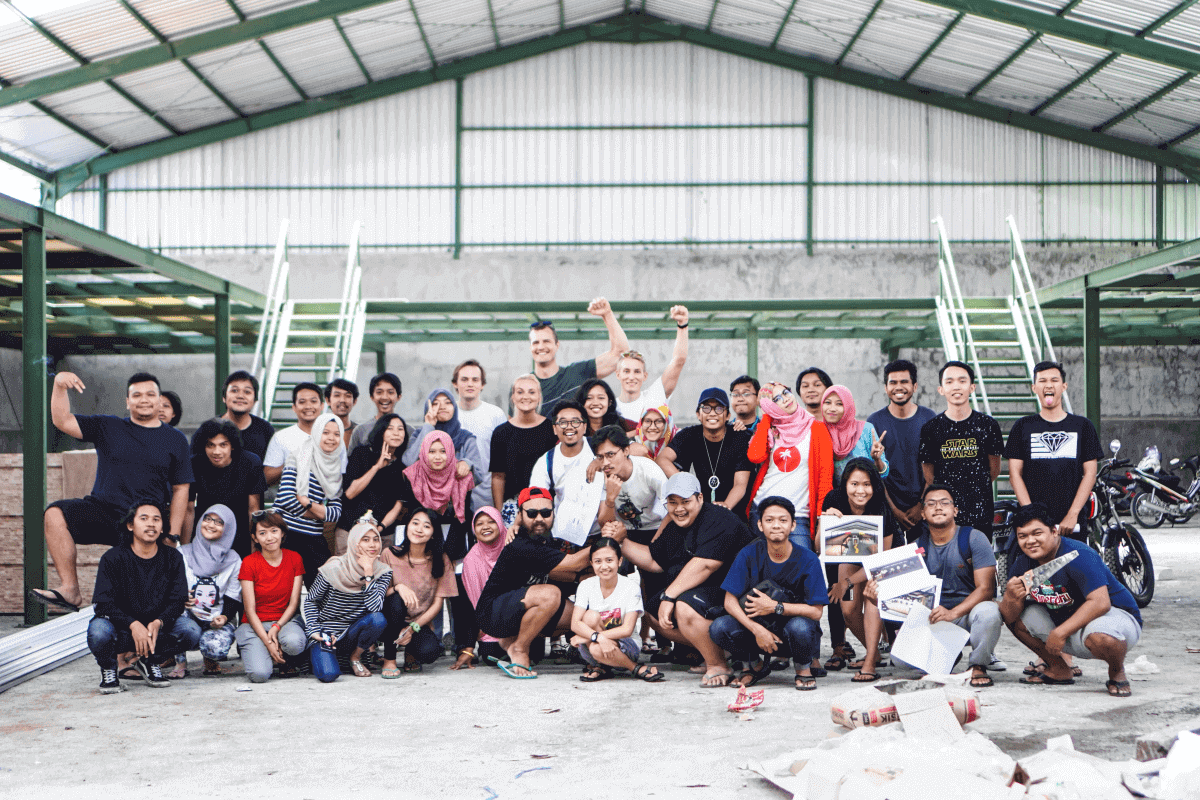
So, is scaling a design team related to hiring more employees?
As we said, it depends on each company's objectives and core business.
In the case of 24Slides, scaling a design team will mean considering hiring more people to meet the growing demand.
This happens because our service involves the creation of high-impact presentations, which are carried out by human individuals. As Lousie said, we constantly work with human talent since our mission is empowering people in emerging markets.
Conversely, a digital marketing agency, for example, may invest in software that offers an automated marketing service, including design tools and mass email delivery.
Thus, from 100 emails a month, they could go to 2000 a month, boosting their services and reducing costs. In this other case, investing in technology will be the best option to scale their design operations.
There can be different scenarios when scaling an in-house design department (not exclusive):
- If your goal is to provide decent work opportunities to more people (like ours), that should be your top priority when scaling your design team.
- If your core business depends on graphic design services, you can invest in software technology and optimize your design operations.
- If your core business does not depend on graphic design services, you can outsource your graphic design needs to a third party and save costs.
Betting on the human mind vs investing in softwares
Until this point, we can say that minimizing reliance on human capital and investing in software could generate more cost savings in your design operations.
In case you decide that for your team scaling process you need to hire more in-house designers, Louise has something to tell you: the human mind is more complex than dealing with software.
There are various theories in business psychology, such as "social loafing in the workplace" or the "Ringelmann effect," which suggest that the team's size can impact an individual's self-perception.
Consequently, the larger the group, the higher the perception that individual efforts are not significant, ultimately affecting performance.
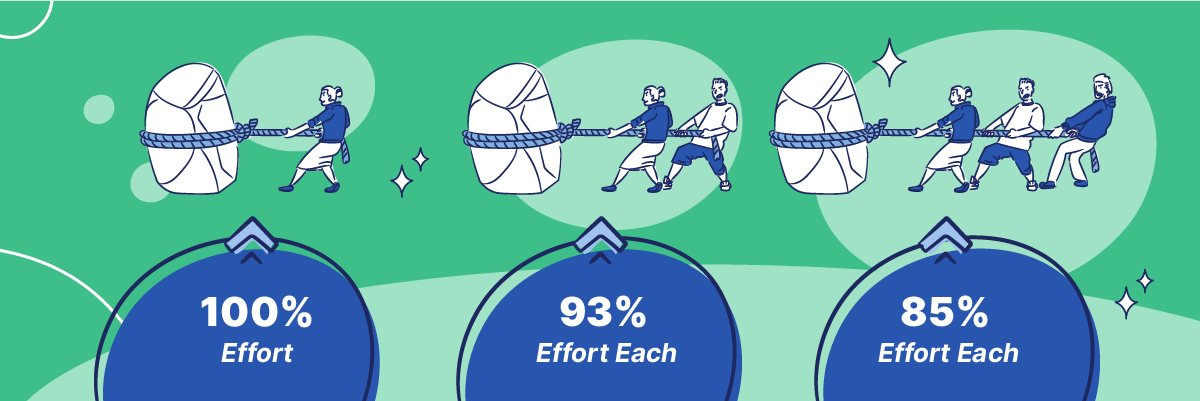
Hiring in-house designers has pros and cons, just like only investing in software or only outsourcing your design work. You need to test and choose which path is best for you.
With these slight distinctions in mind about scaling a design team, we invite you to continue reading the next section. Stay tuned!
When are you ready to scale your In-house Design Team?
Once you have established a high-quality product or service and started growing your revenue, learning how to scale your in-house design team is essential. Ensuring you are at the right stage to scale is the first step to guarantee your success.
It's important to recognize that, like expanding your sales or marketing team, the in-house design department may also experience increased responsibilities. Consequently, it is crucial to contemplate expanding your workforce in this area or optimizing some operational processes.
We understand this decision can be challenging, that's why we want to share some guiding questions:
- Are my performance metrics what I expected or more than I expected? Is my in-house design team a key player in this result?
- Do I identify bottlenecks related to my in-house design team's performance?
- Have I noticed the constant delay of deadlines in my in-house design team? What can I do about it?
- Do I turn away clients because my in-house design team's capacity is not enough?
- Do my in-house designers show ownership? If so, is it the right moment to increase the responsibilities and hire more designers?
- Should I expand my range of products or services? To what extent does my in-house design team play a role in this expansion?
- Do I have a stable client portfolio or income?
- Do I have a positive cash flow? If not, can I correct it in the short term?
If you answered affirmatively to the majority of the questions, it might be the right moment to consider scaling your design operations.
We recommend you discuss these questions with your team. You will see better results at the end of the day!

How to scale your In-house Design Team?: 5 valuable lessons
The million-dollar question: How to scale your in-house design team?
Up to this point, some other questions arise: How do you deal with the changes that, sometimes, need to be done so quickly? And more importantly, how do you achieve it in a way that can support constant growth?
From our experience, the real secret on how to scale in-house design teams is to build and structure teams that are scalable from their conception. This means creating flexible team design structures where people are not only prepared but eager for changes.
Once you get that straight, we'd like to share 5 valuable lessons we have learned from leading in-house designers over the past decade. Keep in mind that all of these lessons are interconnected, so scaling your design operations should be a holistic mission.
1. Define your organization's system
Internal designers or in-house designers are meant to support several different departments and requests simultaneously. It's common for leaders and co-workers to be unaware of the workload required from them.
If you identify this practice in your company, these steps will help you to clarify your organization system:
- Find a comprehensive way to track design demand. This can be complicated at the beginning, but you need to create an internal design workflow or a management system that organizes design tasks by priority.
- Analyze the workload with your team. Once you can track all the tasks, it's now a matter of deciding if the workload is comfortable for your in-house designers. You can distribute the tasks based on your designers' skills and experience in this step.
- Identify demand spikes in the long term. The workload will not always be linear, so it is essential to identify peaks in demand and analyze if it's a one-time event or if it will become a recurring phenomenon in your design operations.
24Slides System: “Points System”
This Point System allows us to identify the workload we can handle every week, ensuring that we meet our client's requirements without compromising quality or overwhelming our in-house designers.
But, how does it work? Certain points are assigned to tasks based on factors such as deadlines and complexity. In this way, each team performs tasks more equally since their workload is based on a determined amount of points.
After a few years of using it, we have achieved greater efficiency in our Design Ops, without burning out our team. Remember: the success of your operations is based on good planning!
"You know your design operations are successful when you no longer experience demand spikes. This is achieved through careful planning, particularly during the busiest seasons."
-Louise Nøhr, Global Head of Operations at 24Slides
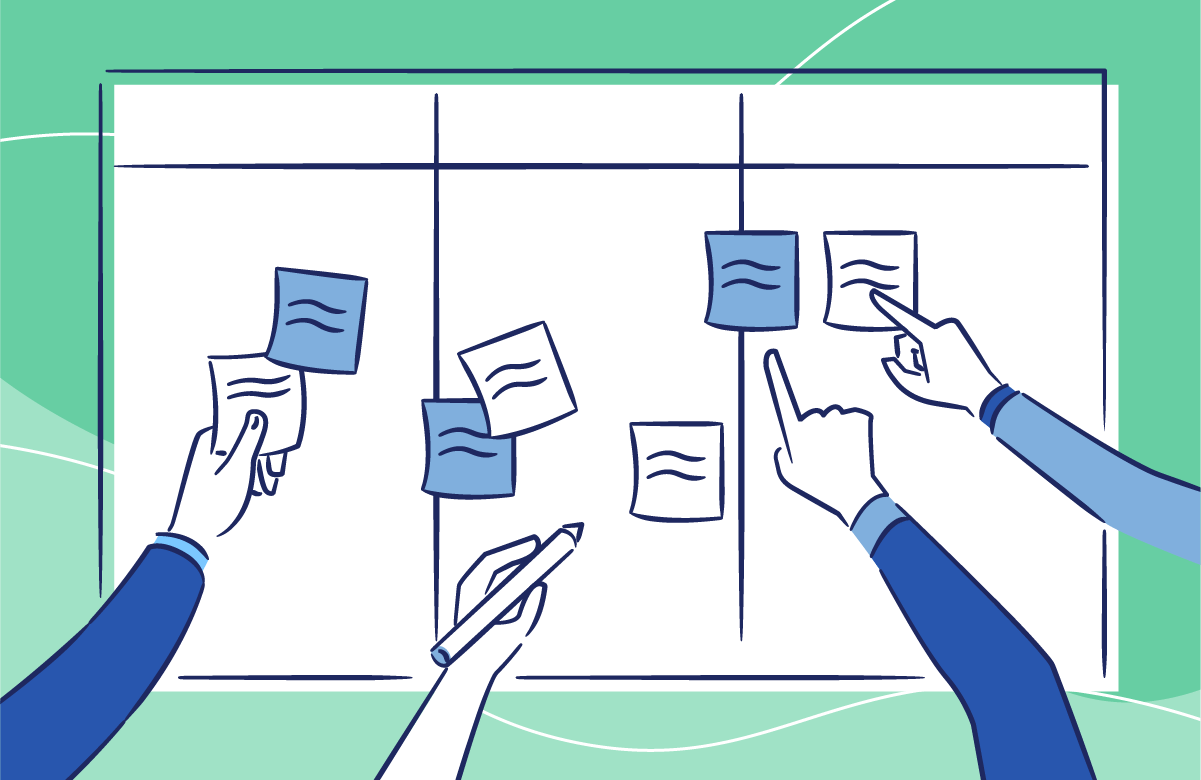
Defining an organization system was the first lesson on our way to comprehending how to scale a design team. The Point System has worked for us, but you need to analyze if it's a match for you considering your business, the type of projects you manage, and your team characteristics.
2. Optimize important internal process
Once you have established a robust organizational system, you can focus on optimizing your company's internal processes.
In the following sections, we will discuss some areas that are really important to optimize in order to achieve the scalability you desire. If you really want to scale your design operations, keep reading!
Optimize your hiring process
When it comes to scaling a design team, hiring new employees is a relevant consideration when the demand has taken a great leap. However, many companies face challenges with this phase, which can become a bottleneck and impede productivity.
To optimize your hiring process, keep the following points in mind:
- Identify the skills and characteristics that are your highest priority. Within an in-house design team, technical skills and experience are often key factors. Additionally, being open to learning and adaptable to change are valuable characteristics during this stage. As the company and design team grow, these criteria can be adjusted.
- Seek human talent that aligns with your company culture. Finding a match between talent and your company culture is complex, so mapping your core values is essential. If you don't have core values yet, this is a sign to start building them.
- Evaluate if using software is convenient. If you typically receive hundreds of resumes, you can automate specific selection processes using technology. Currently, several software options are available to assist you, including Workday, Workable, Harver, and Test Gorilla.
At 24Slides, our hiring process posed a significant challenge due to our rapid growth rates. We've implemented a thorough hiring process that allows us to evaluate candidates' skills and willingness to adapt to the company.
Optimize your onboarding process
You cannot expect to scale your in-house design team without optimizing your onboarding processes. According to a study from Brandon Hall Group, effective onboarding leads to an 82% retention rate of new staff and improves productivity by 70%.
As mentioned earlier, scaling a design team is closely tied to increasing productivity, so don't underestimate this stage.
Follow these suggestions to successfully onboard your in-house designers and maximize their potential:
- Assign a buddy to the new employee. Joining a new company can be a significant challenge, even for individuals who adapt quickly to change. A valuable strategy is to assign a buddy who will serve as a guide and mentor during the newcomer's first months.
- Design an action plan. Onboarding a new employee often involves completing paperwork, creating an introductory space with colleagues, and providing an overview of the company's history and stakeholders. Identify all these tasks and develop an action plan with specific deadlines.
- Foster a sense of belonging. Cultivating a sense of belonging is a crucial step during the onboarding phase. Consider providing a welcome kit or other creative initiative to make new employees feel included and valued.
- Automate the process. Some onboarding tasks can be repetitive and thus automated. Explore software solutions like HiBob, TalentLMS, Deel, and Monday.com to streamline and automate these processes.
In our case, we have a Training Specialist that invests substantial time and resources in ensuring that new in-house designers are prepared to maintain the high quality we're known for. While this practice may result in more extended onboarding periods before new hires join their teams, we've found it is worthwhile in the long run.
Furthermore, we also bet on technology to automate certain Onboarding and HR processes. This is not only beneficial for internal designers, but for HR staff as well.
"Currently, we rely on a Human Resources Information System (HRIS) that automates our Onboarding process, facilitates the registration of absences and vacations, prepares KPIs & Analytics of different aspects related to employees. This empowers HR professionals to concentrate on high-value tasks that drive organizational growth, liberating them from managing voluminous worker data and repetitive operational tasks."
-Mauro Ramirez, People & Impact Manager at 24Slides
By implementing these scaling strategies, you can enhance your onboarding experience and ultimately drive productivity and retention within your in-house design team.
Optimize your operational process
If you're clear on lesson 1 of this guide on how to scale a design team, then let's delve further into that aspect here. Based on our 10-year experience, Louise pointed out some key points that will be useful for scaling your Design Ops:
- Prioritize quality over quantity of work.
- Reduce manual labor through technological infrastructure.
- Seek ways to standardize products and processes.
- Maintain constant communication with clients (internal and external).
Talking about the optimization of design operations also implies talking about technology. We've developed an enterprise solution that helps us connect in-house designers and other internal departments (internal clients), resulting in a more efficient process.
Here is a brief overview of how we manage our design workflow:
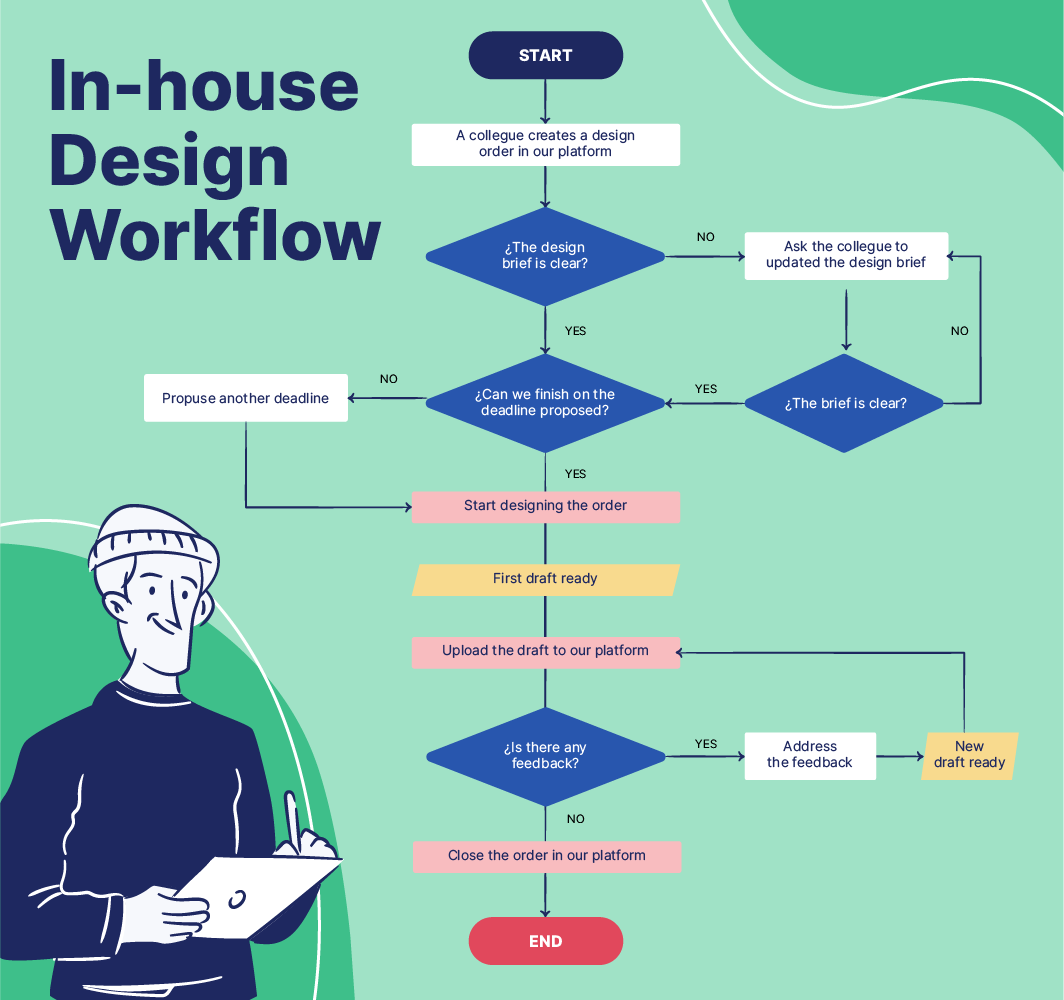
As you can see, this process becomes easier when you organize and follow it step by step.
It is important to note that having a Design Ops Manager is crucial for optimizing this process, as they will oversee the proper functioning of your design workflow and make any necessary changes.
Do you want to learn more about scaling your design operations? Keep an eye out for the following section!
3. Ensure a professional career path
Besides a prolonged training time, we believe that creating spaces for individual development makes a big difference when scaling your in-house design team.
One thing that we really focus on is upskilling and contributing to employees' career paths. That way, in the long run, more senior employees can guide and assist new hires.
Professional career path
Without a clear career path structure and the motivation to grow into new roles, employees could look for other job opportunities. That's why you must ensure a professional career path from the beginning (of course, employee performance is a factor to consider too).
At 24Slides, we have developed internal team structures that facilitate professional growth. Working with designers in different roles and levels of experience (such as manager, senior and junior) is one of the scale strategies that most help us.
Structuring our team that way, Design Managers handle fewer design tasks since their role also involves supervising and nurturing the new ones. As an entry-level designer gains experience and becomes eligible for promotion, we open a job vacancy for a new designer.
This career pipeline system enables us to continuously scale our graphic design teams and onboard new designers, without compromising our production or the final quality of the service.
Personal and skills growth
When discussing how to scale a design team, personal growth and skill development are crucial if you expect long-term goals for your team.
The most common approach to address this is by investing in online courses or workshops that cover various topics, including:
- Soft skills: communication skills, active listening, conflict management, time management, growth mindset, work ethic, self-awareness, etc.
- Hard skills: design software, project management, workload management and quality assurance, languages, etc.
Investing in developing your team skills is a competitive advantage since it helps retain talent and facilitates the scaling process of your design operations. Do not forget!
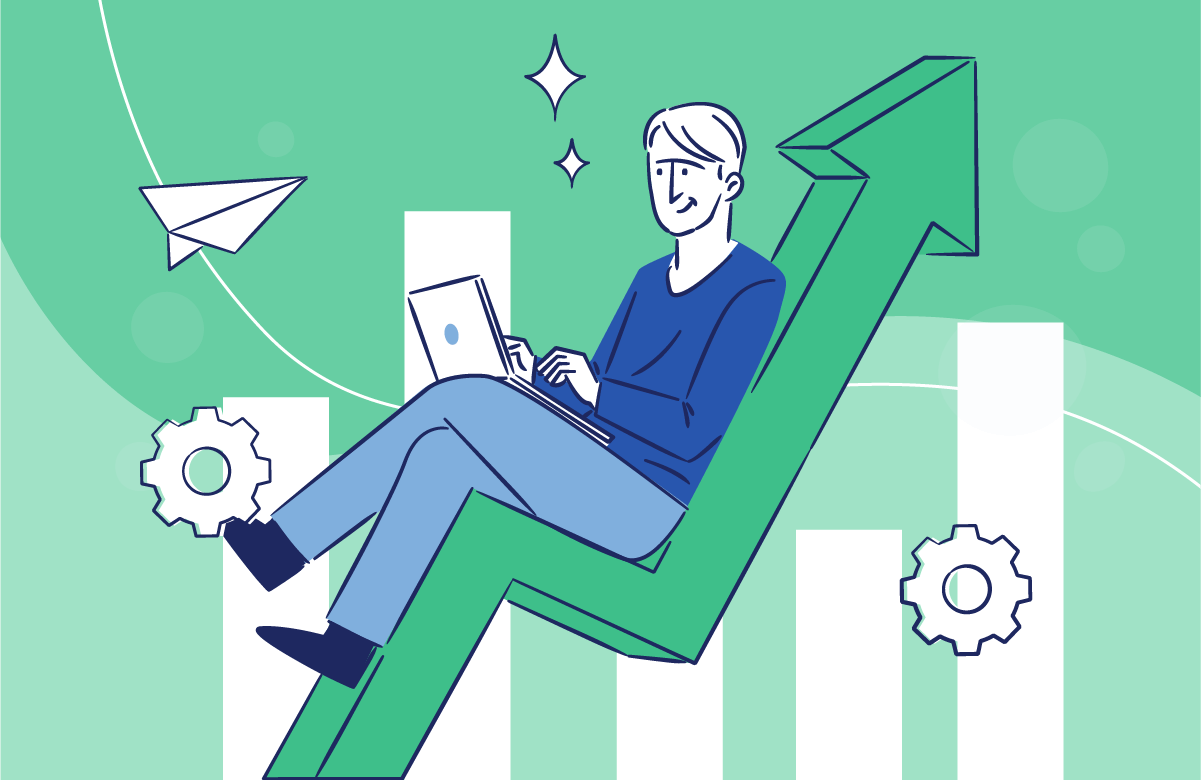
Are you enjoying this article? Keep going, we're not done sharing how to scale your in-house design team!
4. Outsource your design work when needed
Many people think of in-house design work and outsourcing as two completely opposite models. However, when structuring your design operations to be scalable, a hybrid model can actually work wonders.
More and more companies nowadays bet on working with dedicated teams to assist their internal designers. These team aren't meant to replace them; rather, they handle the extra workload, allowing in-house designers to concentrate on other crucial tasks. That way, you can scale your design operations at a desired pace, prioritizing quality over speed.
We at 24Slides collaborate with several companies and their in-house design teams to foster synergy and achieve their goals efficiently. Get to know our dedicated design team service a little more here:
- A Dedicated Account Manager that will support you in the onboarding process and solve any issue within your design team.
- Design orders in a maximum of 24 hours.
- Confidentiality at every step of the process.
- You have the option to create a platform to maximize efficiency and make the integration seamless.
Furthermore, investing in diverse graphic design teams creates an environment rich in innovation, as their varied backgrounds and potential cultural differences serve as the perfect input to solve problems and diversify your products. This is another advantage of outsourcing to keep in mind!

You've come a long way in this guide on how to scale your graphic design team. Do not miss the last section!
5. Focus on improving your company culture
You cannot scale your in-house design operations without scaling your company culture. Team morale and company culture are vital to building a successful scaling process. If you are planning to scale your operations, you must have a strong company culture.
The only constant in a growth process is that there will be changes. The main goal in this journey is to make your internal design team excited and comfortable about it, not overwhelmed.
Keep the following points in mind when scaling your company culture:
Build good practices in teamwork
Feeling supported and encouraged is an essential value for every employee. Let's explore how you can enhance your work environment:
- Clearly define the roles of each employee. It's important to determine the tasks of each team member to avoid duplication of efforts. This can result in wasted time and a perception of poor organization.
- Foster a culture of feedback. Feedback improves your product's quality and contributes to your team's professional growth. Remember that it should be constructive criticism, and it's ideal to have a well-established process for providing it.
- Promote messages of recognition. Recognizing achievements and extra efforts has a significant impact on employee motivation. You can establish mechanisms to make it a regular practice in your company.
- Organize team-building activities. Building cohesion within your team is crucial for generating better project outcomes and fostering trust and commitment among team members.
Care about mental health
Due to the global pandemic and various political conflicts, everyone's daily lives have undergone significant changes. Therefore, the importance of mental health when scaling your design operations shouldn't be overlooked.
At the end of the day, an employee who is not at 100% will not work as they usually do and, in the worst-case scenario, may consider leaving the company. So, what actions can you take to address this?
- Foster a culture of prevention. There are various ways to identify cases where mental health is not optimal. For example, conducting anonymous surveys, holding regular meetings to discuss non-work-related issues, or investing in mental health courses. Providing wide-ranging health insurance and promoting its utilization is also a significant step.
- Encourage work-life balance. Promoting a healthy balance is fundamental to ensuring employee happiness and motivation. You can offer flexible work schedules and respect vacation time.
- Promote healthy habits. Employees highly value the benefits you can provide them, such as subsidized gym memberships, yoga classes, partnerships with healthy food companies, among others. These actions demonstrate your commitment to their well-being.
Establish clear core values
The foundation of a strong company culture lies in its core values. While your in-house design team may experience rapid growth and face numerous changes, core values should remain consistent throughout the process.
“In a growing team, one of the challenges is keeping everyone aligned and synchronized while the number of people keeps increasing or even multiplying. This is where core values hold us together, as a link that keeps us on the same page - on the same bases.”
-Himawan Prakosa, Talent Development Manager at 24Slides
If you still need to establish solid values within your team, Himawan will provide you further insights explaining our core values at 24Slides.
Promote clear performance results
It's often said that what is not measured does not exist. When scaling your in-house design team, measuring results is the best way to evaluate productivity and its correlation with your financial performance.
Some metrics you can consider to track your in-house creative team include:
- Project delivery time
- Customer return rate
- Customer satisfaction
- Average project cost
According to McKinsey & Company, the most successful design departments empower their internal designers by assigning projects where they can make tangible improvements and ultimately have a significant impact on society.
In other words, employees like to see how their work benefits the community or stakeholders. These results are not only metrics but also show the real impact that your team can achieve, which is a source of motivation.
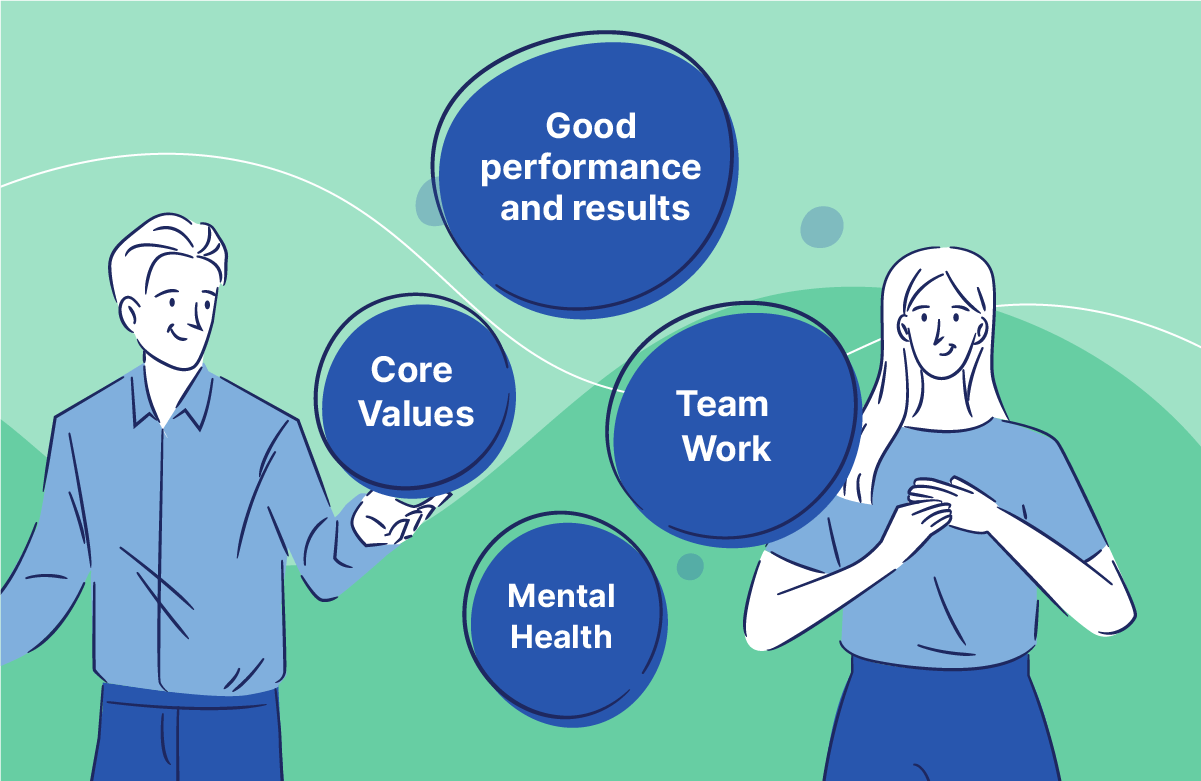
Conclusions
How to scale your internal design team without failing? We can answer that it's not about your team's size itself, it's about the performance achieved without leaving aside your company's objectives and culture.
Over our ten years of experience, we've learned that a slow and steady approach is the key to scaling an in-house design team. In summary:
- While accurately forecasting our design demand and taking advantage of technological systems, we proactively stay ahead and avoid employee burnout.
- However, these operational practices cannot simply drift, they must be strengthened with a cohesive culture and values that will keep our team together through changes.
- Remember that the process of scaling is not black and white. If your company needs to incorporate new employees, go ahead. But if you can opt for other scaling strategies, don't be afraid to try them (or mix them).
- Last, but not least, not all companies are ready to scale their teams. Evaluating your current stage and identifying your available resources should be the first steps to care about.
We hope we've answered all your questions about how to scale an in-house design team nowadays. See you soon!

You'll enjoy these readings too:




